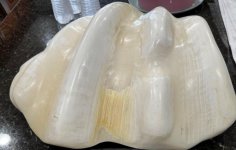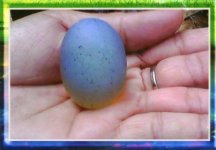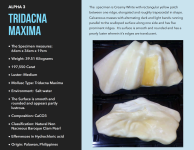jshepherd
Pearl Paradise
- Joined
- Jun 22, 2004
- Messages
- 6,344
Over the past few years, we've been inundated with images and claims of supposed giant clam pearls, almost all of which come from the Philippines.
This is likely due to a story about a supposed 75-pound pearl (34 kilo) a Filipino fisherman had kept under his bed for a decade.
The story was reported on by NPR, Smithsonian Magazine, Forbes and so many more. Unfortunately, none of these publications vetted the claims made before picking up the story. Any expert could have told them it was not a pearl. It was a piece of shell.
In 2017, SSEF published a Gemmological Brief on fake Tridacna pearls, and specifically included this supposed 34-kilo pearl.

These are not pearls. These are pieces of shell.



















In case you're curious, These are what real Giant Clam pearls look like.
 www.pearl-guide.com
www.pearl-guide.com

 www.pearl-guide.com
www.pearl-guide.com

 www.pearl-guide.com
www.pearl-guide.com

 www.pearl-guide.com
www.pearl-guide.com

 www.pearl-guide.com
www.pearl-guide.com

 www.pearl-guide.com
www.pearl-guide.com

 www.pearl-guide.com
www.pearl-guide.com

 www.pearl-guide.com
www.pearl-guide.com

 www.pearl-guide.com
www.pearl-guide.com

This is likely due to a story about a supposed 75-pound pearl (34 kilo) a Filipino fisherman had kept under his bed for a decade.
The story was reported on by NPR, Smithsonian Magazine, Forbes and so many more. Unfortunately, none of these publications vetted the claims made before picking up the story. Any expert could have told them it was not a pearl. It was a piece of shell.
In 2017, SSEF published a Gemmological Brief on fake Tridacna pearls, and specifically included this supposed 34-kilo pearl.
These are not pearls. These are pieces of shell.



















In case you're curious, These are what real Giant Clam pearls look like.
This is Not a Pearl
This is not a pearl. The giant clam, Tridacna gigas, is under attack. The rumor mill never rests on the subject of giant clam “pearls”. They are supposed to be worth millions, if not hundreds of thousands of dollars. Clam pearls, technically calcareous concretions, do exist. Good clam pearls...

More Fake Tridacna - Gigantic Pearls
Hello to everyone. Any idea what to do with those two pearls? earrings for the sphinx of Egypt!!! Tridactna Maxima 64cmx34cmx19cm - 39,51 Kilograms - 197,550 carats Tridactna Gigas 36cmx36cmx22cm - 21.39 Kilograms - 106.950 carats Where I can sell those Pears?

Another Fake giant clam pearl
how much could I sell this 18kgs giant clam pearl?

7.3 kilo giant clam white pearl from palawan philippines
We found a 7.3 kilo giant pearl in Palawan Philippines. It could be the largest pearl in the world. An expert have already checked the giant pearl and said that it is authentic and it cost about $450,000 or above. Is there any expert that can also check the value of this giant pearl? We are also...

I have a clam Pearl..how do i find a buyer??
Hello forum I am hoping this is the correct area for this post.. I apologize to the mods if it isn't! So, my family had a giant clam Pearl that was found in the Philippines and now it is mine. I am trying to find how I can find a private seller, I do not want to do auctions at all The Pearl...

This is true pearl. And howmuch if i sell this thankyou
Im from philippines somewhere in palawan my friend took this pearl. And he have a legal documents for test. I hope you guys help me where this pearl sell. if you trying to fool me. I dont have time for you. Thankyou. 26kgs this pearl not 36 wrote on (pearl)

Clam pearl
I have a clam pearl of Tridacna gigas, weighing 120 KGS., although it is not yet cleaned.

Our Giant 7.3 kilo clam white Pearl

Giant clam pearl found in Palawan
Hello all, I'm trying to find out the value of a pearl found in Palawan. It weighs about 2.7 kgs. I wonder if it's worth anything? The other photo is a blue stone found in a mountain. It glows when placed in water. Anyone ever heard of it? I wanted to find out more about it also but can't seem...

